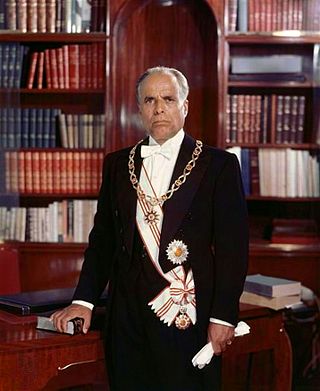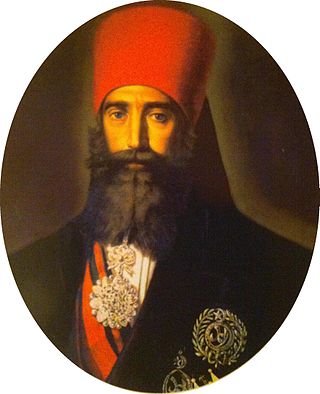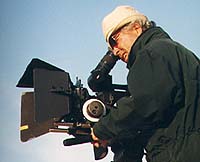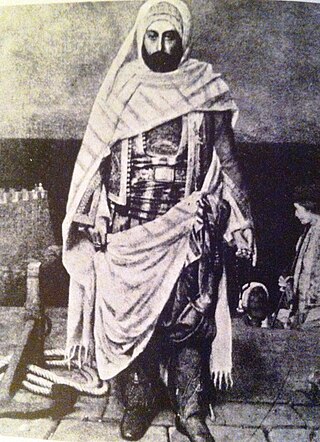
Tunis is the capital and largest city of Tunisia. The greater metropolitan area of Tunis, often referred to as "Grand Tunis", has about 2,700,000 inhabitants. As of 2020, it is the third-largest city in the Maghreb region and the eleventh-largest in the Arab world.

Habib Bourguiba was a Tunisian lawyer, nationalist leader and statesman who led the country from 1956 to 1957 as the prime minister of the Kingdom of Tunisia (1956–1957) then as the first president of Tunisia (1957–1987). Prior to his presidency, he led the nation to independence from France, ending the 75-year-old protectorate and earning the title of "Supreme Combatant".

Muhammad VII al-Munsif, commonly known as Moncef Bey was the Bey of Tunis between 19 June 1942 and 14 May 1943. He was the penultimate ruler of the Husainid dynasty.

Muhammad VIII al-Amin commonly known as Lamine Bey, was the last Bey of Tunis, and also the only King of Tunisia.

Tunisian independence was a process that occurred from 1952 to 1956 between France and an independence movement, led by Habib Bourguiba. He became the first Prime Minister of the Kingdom of Tunisia after negotiations with France successfully brought an end to the colonial protectorate and led to independence.

The Beylik of Tunis was a de facto independent state located in present-day Tunisia, formally part of the Ottoman Empire. It was ruled by the Husainid dynasty from 1705 until the establishment of the French protectorate of Tunisia in 1881. The term beylik refers to the monarch, who was called the Bey of Tunis. Under the protectorate, the institution of the Beylik was retained nominally, with the Husainids remaining as largely symbolic sovereigns.

Ahmad I, born 2 December 1805 in Tunis died 30 May 1855 at La Goulette, was the tenth Husainid Bey of Tunis, ruling from 1837 until his death. He was responsible for the abolition of slavery in Tunisia in 1846.
Mahmoud Djellouli (1755–1839) was a trader and Tunisian diplomat. He was a member of the same clan as Youssef Saheb Ettabaa and among the important figures of his time.

Yahia Turki,, was a Tunisian painter described as the "father of Tunisian painting". After the Independence in 1956, Yahia became the president of l'Ecole de Tunis, which was created in 1947 by Pierre Boucherle in an attempt to gather Tunisian artists, regardless of their religious, racial, or artistic background, and with the common interest of establishing a Tunisian painting style.

The cinema of Tunisia began in 1896, when the Lumière brothers began showing animated films in the streets of Tunis.
M'hamed Djellouli was a Tunisian politician who served as Prime Minister of Tunisia from 1907 until his death in 1908.
The Turks in Tunisia, also known as Turco-Tunisians and Tunisian Turks, are ethnic Turks who constitute one of the minority groups in Tunisia.

Kaouther Ben Hania also written Kaouther Ben Henia or Kaouther Benhenia is a Tunisian film director. Her 2017 film Beauty and the Dogs was selected as the Tunisian entry for the Best Foreign Language Film at the 91st Academy Awards. Her 2020 film The Man Who Sold His Skin was nominated for the Best International Feature Film at the 93rd Academy Awards. Her 2024 film Four Daughters was nominated for Best Documentary Feature at 96th Academy Awards.

Albert Samama Chikly, was a Tunisian filmmaker and photographer. Considered one of the earliest pillars in World Cinema, Albert was a photographer, filmmaker, technophile, adventurer, and cyclist.
Youssef Saheb Ettabaa, was a Tunisian politician and a mameluk of Moldavian origin. He became a Prime Minister of the Beylik of Tunis.

Mohammed Aziz Bouattour, was Prime Minister of the Beylik of Tunis from 1882 to 1907.
The Ministry of the Pen was a ministerial position in Tunisia between 1860 and the end of the monarchical regime in 1957.
Nassim Shamama or Nessim Scemama was a Tunisian businessman and philanthropist. As a Tunisian Jew, he held the role of caïd (head) for the Jewish community of the country. He also worked for the Husseinid beys, occupying the post of Receiver General and then Director of Finance. After amassing a huge fortune from his official positions he left Tunisia and after his death his estate became the subject of several famous and protracted international lawsuits.

Mahmoud Ben Ayed, Mahmoud Ben Ayad, born in 1805 in Tunis and died in 1880 in istanbul, was a Tunisian politician. His misappropriation of funds while in office led the Tunisian state to bankruptcy and financial dependence on Europe, and was thus one of the causes of the establishment of the French protectorate of Tunisia.

Abdellatif Ben Ammar was a Tunisian film director and screenwriter.














